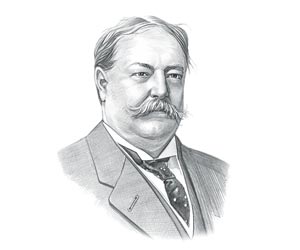|
The
major accomplishments and the famous, main events that
occurred during the time that William Taft was president
included the Antitrust Policy, the
Ballinger-Pinchot affair and the 1909 Payne-Aldrich
Tariff Act. The Angel Island Immigration Station opened
on January 21, 1910 in San Francisco Bay, California and
the world was shocked by the Sinking of the Titanic in
1912. William Taft died
of a heart attack on March 8, 1930, aged 72. The next president was
Woodrow Wilson.
Birthday:
September 15, 1857
Place of Birth:
Ohio
Political Party:
Republican
Nickname: Big
Lub
Number: 27th
President
Vice President:
James S. Sherman
Age at Inauguration:
51
Height: 6 feet
Weight: 316
pounds
First Lady:
Helen Taft
Religion:
Unitarian
Date of Death:
March 8, 1930
Date of William
Taft
Presidency: March 4,
1909 to March 4, 1913
The Nickname of William Taft: "Big Lub"
The nickname of President William Taft provides an insight into how the man
was viewed by the American public during his presidency. The meaning
of the nickname "Big Lub" together with "Big Will" and
"Big Chief" are a reference to his large size. His wife, Helen Taft,
gave him the nickname of the "Sleeping Beauty" due to his habit of
falling asleep on car rides.
Character and Personality Type of William Taft
The character traits of President William Taft can be described as
outgoing, genial, gregarious, amiable and diligent, with a strong
sense of responsibility. It has been speculated that the Myers-Briggs
personality type for William Taft is an ESFJ (Extraversion, Sensing,
Feeling, Judgment). An outgoing, sociable, expressive character and
a nurturer of established social institutions. William Taft Personality
type: Friendly, gregarous, cooperative, observant and informative.
Accomplishments of William Taft and the Famous Events during his Presidency
The accomplishments of William Taft and the most famous events during his
presidency are provided in
an interesting, short summary format
detailed below.
The Progressive Movement
Summary of the Progressive Movement: The
Progressive Movement
and
Progressive Reforms
continued during the presidency of
William Taft addressing political and
social reforms relating to working conditions,
child labor, education and female suffrage. Bribery and corruption,
the political machines and unfair business practices were also
attacked.
Taft's Dollar Diplomacy
Summary of the Taft's Dollar Diplomacy: The foreign policy of the
administration was known as
Taft's Dollar Diplomacy
(1909 to 1913) and was designed to increase the economic power of
the US, promoting trade in Latin America, the Caribbean, West Africa
and East Asia. It also aimed at preventing foreign powers from
increasing their financial foothold in key markets. William Taft's
dollar diplomacy failed to counteract economic and political
instability and resulted in animosity against the United States.
Payne-Aldrich Tariff Act of 1909
Summary of the Payne-Aldrich Tariff Act of 1909: The
Payne-Aldrich Tariff Act of 1909
was designed to lower tariff rates
but but also enacted a corporation tax.
The law alienated President William Taft from the Progressives and
Conservative Republicans who criticized the president for
being weak and indecisive.
1909 Ballinger-Pinchot Scandal
Summary of the Ballinger-Pinchot Scandal: The
Ballinger-Pinchot Scandal
exploded in November 1909
when conservationist Gifford Pinchot
revealed that Richard Ballinger, the Secretary of the
Interior, had made nearly 1 million acres of Alaskan public forests
and coal fields open to private development.
US and the Mexican Revolution
Summary of the US and the Mexican Revolution: The
US and the Mexican Revolution
(1910 - 1920)
saw two episodes of intervention and involvement by the US in the
Mexican Revolution
led by revolutionaries including Francisco "Pancho"
Villa and Emiliano Zapata Salazar.
Mann-Elkins Act of 1910
Summary of the Mann-Elkins Act of 1910: The
Mann-Elkins Act of 1910
set railroad rates and regulate the telecommunications
industry. The
new law extended the authority of the Interstate
Commerce Commission (ICC) to cover telephones, telegraphs and radio
companies.
1910 Postal Savings System
Summary of the Postal Savings System: The
Postal Savings System
was established by the Postal Savings Depository Act
of 1910 introducing a system whereby certificates or savings stamps
were issued to depositors as proof of their deposit and could be
exchanged in amounts of $20 or more for postal savings bonds.
1910: Angel Island Immigration Station
Summary of the Angel Island Immigration Station: The
Angel Island Immigration Station
was opened
on January 21, 1910
in San Francisco Bay, California
as a detention center for immigrants
from China, Japan and Asia.
1912: Alcatraz Prison
Summary of Alcatraz Prison: The new
Alcatraz Prison construction was completed in 1912 as a high
security penitentiary to house murderers, gangsters and bank
robbers.
1912: Sinking of the Titanic
Summary of the Sinking of the Titanic: The
Sinking of the Titanic
occurred on 15 April 1912 when the British
passenger ship struck an iceberg and sank into the North Atlantic
Ocean. A total of 1523 people died, there were only 705 survivors on
the "unsinkable" ship.
|

